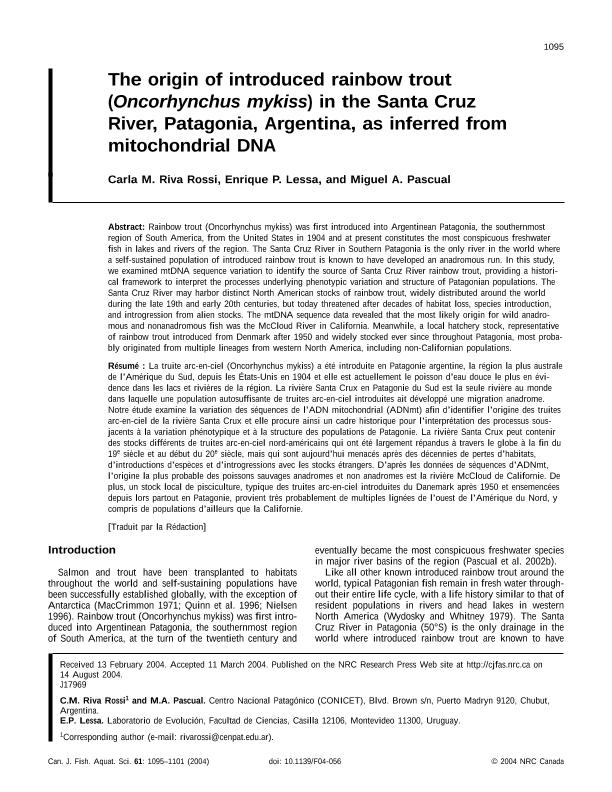Artículo
Rainbow trout (Oncorhynchus mykiss) was first introduced into Argentinean Patagonia, the southernmostregion of South America, from the United States in 1904 and at present constitutes the most conspicuous freshwaterfish in lakes and rivers of the region. The Santa Cruz River in Southern Patagonia is the only river in the world wherea self-sustained population of introduced rainbow trout is known to have developed an anadromous run. In this study,we examined mtDNA sequence variation to identify the source of Santa Cruz River rainbow trout, providing a historicalframework to interpret the processes underlying phenotypic variation and structure of Patagonian populations. TheSanta Cruz River may harbor distinct North American stocks of rainbow trout, widely distributed around the worldduring the late 19th and early 20th centuries, but today threatened after decades of habitat loss, species introduction,and introgression from alien stocks. The mtDNA sequence data revealed that the most likely origin for wild anadromousand nonanadromous fish was the McCloud River in California. Meanwhile, a local hatchery stock, representativeof rainbow trout introduced from Denmark after 1950 and widely stocked ever since throughout Patagonia, most probablyoriginated from multiple lineages from western North America, including non-Californian populations. La truite arc-en-ciel (Oncorhynchus mykiss) a été introduite en Patagonie argentine, la région la plus australe de l’Amérique du Sud, depuis les États-Unis en 1904 et elle est actuellement le poisson d’eau douce le plus en évidence dans les lacs et rivières de la région. La rivière Santa Crux en Patagonie du Sud est la seule rivière au monde dans laquelle une population autosuffisante de truites arc-en-ciel introduites ait développé une migration anadrome. Notre étude examine la variation des séquences de l’ADN mitochondrial (ADNmt) afin d’identifier l’origine des truites arc-en-ciel de la rivière Santa Crux et elle procure ainsi un cadre historique pour l’interprétation des processus sousjacents à la variation phénotypique et à la structure des populations de Patagonie. La rivière Santa Crux peut contenir des stocks différents de truites arc-en-ciel nord-américains qui ont été largement répandus à travers le globe à la fin du 19e siècle et au début du 20e siècle, mais qui sont aujourd’hui menacés après des décennies de pertes d’habitats, d’introductions d’espèces et d’introgressions avec les stocks étrangers. D’après les données de séquences d’ADNmt, l’origine la plus probable des poissons sauvages anadromes et non anadromes est la rivière McCloud de Californie. De plus, un stock local de pisciculture, typique des truites arc-en-ciel introduites du Danemark après 1950 et ensemencées depuis lors partout en Patagonie, provient très probablement de multiples lignées de l’ouest de l’Amérique du Nord, y compris de populations d’ailleurs que la Californie.
The origin of introduced rainbow trout (Oncorhynchus mykiss) in the Santa Cruz River, Patagonia, Argentina, as inferred from mitochondrial DNA
Fecha de publicación:
12/2004
Editorial:
National Research Council Canada-NRC Research Press
Revista:
Canadian Journal Of Fisheries And Aquatic Sciences
ISSN:
0706-652X
Idioma:
Inglés
Tipo de recurso:
Artículo publicado
Clasificación temática:
Resumen
Palabras clave:
INTRODUCED SPECIES
,
MITOCHONDRIAL DNA
,
POPULATION GENETICS
,
PROVENANCE
Archivos asociados
Licencia
Identificadores
Colecciones
Articulos(CCT-CENPAT)
Articulos de CTRO.CIENTIFICO TECNOL.CONICET - CENPAT
Articulos de CTRO.CIENTIFICO TECNOL.CONICET - CENPAT
Citación
Riva Rossi, Carla Marcela; Lessa, Enrique P.; Pascual, Miguel Alberto; The origin of introduced rainbow trout (Oncorhynchus mykiss) in the Santa Cruz River, Patagonia, Argentina, as inferred from mitochondrial DNA; National Research Council Canada-NRC Research Press; Canadian Journal Of Fisheries And Aquatic Sciences; 61; 7; 12-2004; 1095-1101
Compartir
Altmétricas




